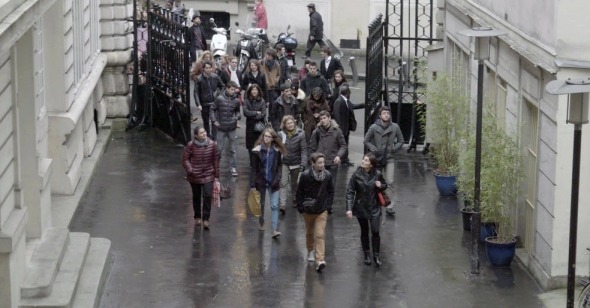Admin Tools
By Tayler Montague
The Competition
Dir. Claire Simon, France, Metrograph Pictures
“It is the right of the citizen to know how it works,” Claire Simon remarked when asked how she was able to get the access necessary to make The Competition. It’s the pulling back of the curtain behind an institution like La Fémis that makes The Competition so compelling. For those unfamiliar, it’s a highly prestigious film school in Paris, many of whose alumni have been honored with top prizes at the Cannes, Venice, and Berlin film festivals. So it’s no surprise that a school with such a reputation also has a rigorous application process. In Simon’s documentary, we see students scramble to complete written exams, using their phone lights after the time has passed and the classroom has gone dark. We see the jitters and nerves typical of the admission process, artists on the precipice of the training that could change their professional lives. All of these images—pen on paper, hands nervously running through hair, ruffling through backpacks—feel as though they’re amplifying the importance of matriculating through La Fémis. However, it’s when those who keep the institution running are on camera that The Competition really comes alive.
Claire Simon has crafted her career on creating immersive documentary films dealing with people and the architectural spaces in which they thrive and make decisions. (Gare du Nord, from 2013, for instance, revolves around a train station and those that populate it.) In The Competition, during a series of interviews (another step in the admissions process, alongside a written exam and submitted film work), future La Fémis graduates run down what films mean to them and how their love of cinema started—at varying levels of comfortability. The biases of the interviewers sometimes feel blatant, as when a blonde, white woman finds camaraderie with an applicant whose responses didn’t come across as particularly special but who looks like herself 20 years younger. (Her co-interviewer jokingly asks, “Are you taken by the accent?” which feels like confirmation of the girl’s mediocrity.)
Next is a Black woman, born in France, who ended up living in Cote d’Ivoire during wartime; she first got into filmmaking as a means to document her country and it became a tool for her to dispel myths about what was happening in the region. It’s far more compelling than the narratives we’d been seeing prior, such as taking a filmmaking class in high school or sneaking into the cinema in a small French town and dreaming of coming to Paris. However, when asked her favorite film, the woman immediately freezes. She is unable to give an answer, and we watch her filmmaking ambitions—or at least her chances at La Fémis—get dashed in real time. It’s jarring to see the interviewers so quickly turn on her, especially after watching instructors squabble over whether a white male applicant’s bad attitude should bar him from entry, grasping for straws about his genius—after all he may be the next Cronenberg or Nicolas Winding Refn.
Although it’s not immediately clear if she has been rejected, my heart broke for the young woman, though I wondered if in some ways she’s better off. Institutions constantly seek to remind us that we’re lucky to be accepted into them, no matter the emotional tolls they may take on our lives, when often they are lucky to have us. And while she may not have the immediate access to resources that La Fémis would allot her, it’s ultimately their loss. (I truly hope she didn’t lose any desire to make films about the Cote d’Ivoire.)
In a staff meeting, one of the school administrators says, “At La Fémis there are no lessons and no teachers. “Yet, despite their democratic approach to teaching, there’s a clear hierarchy in place. In any scene that focuses on the gatekeepers of La Fémis, it’s notable how overwhelmingly white they are. This is most curious in our contemporary moment, where we’re watching countries the world over seek to preserve whiteness, and in doing so, cut off their nose to spite their face (Brexit). In some ways, the attempts to give an insider look at La Fémis confirm precisely what we know about prestigious institutions. They favor white people and they’re run by them, and the requirements for admission stand as a barrier of entry to many.
Claire Simon’s camera is the Trojan horse. With her cut-and-dried filmmaking (not to be confused with simplicity), she puts us in these rooms to observe. In demystifying the process of getting into one of the most prestigious film schools in the world, she exposes the ambivalence about race and class and the overall blindness to conversations surrounding diversity and inclusion that remain at the core of these institutions. She clearly devoted tireless hours to rendering herself invisible so that the powers that be grew comfortable enough to tell on themselves. The Competition is an examination of power. There is democracy at play here, dispelling the myth-making surrounding La Fémis, allowing potential future applicants to see it for what is before choosing to bring their brilliance to the school. And we have Simon to thank for that.
